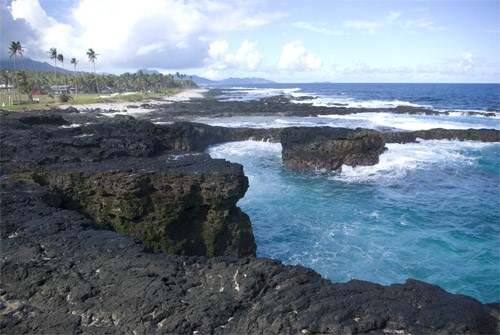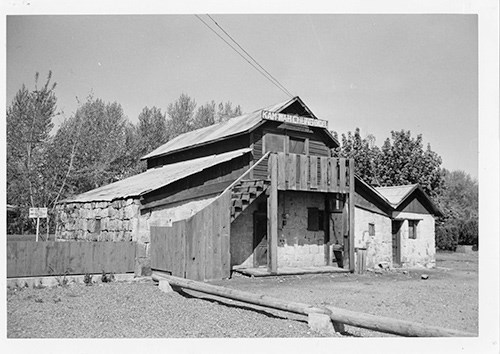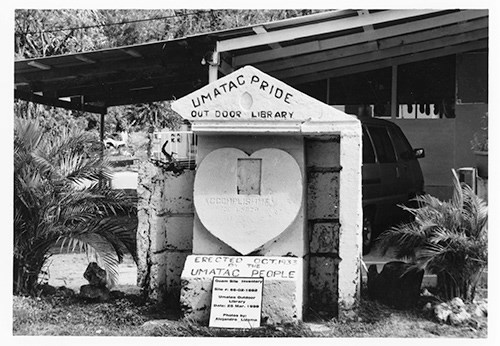The National Register of Historic Places is the official list of the Nation's historic places worthy of preservation. Authorized by the National Historic Preservation Act of 1966, the National Park Service's National Register of Historic Places is part of a national program to coordinate and support public and private efforts to identify, evaluate, and protect America's historic and archeological resources.
The National Register of Historic Places recognizes the historical contributions of Asian and Pacific peoples in the United States and its associated territories. From the early 1800s to the 21st century, Asian and Pacific peoples have played a vital role in the development of the United States and made lasting contributions in all elements of American society. The month of May is Asian-Pacific American Heritage Month and this site showcases historic properties listed in the National Register and National Park units highlighting important aspects of the Asian and Pacific experience in America.
The National Register of Historic Places recognizes the historical contributions of Asian and Pacific peoples in the United States and its associated territories. From the early 1800s to the 21st century, Asian and Pacific peoples have played a vital role in the development of the United States and made lasting contributions in all elements of American society. The month of May is Asian-Pacific American Heritage Month and this site showcases historic properties listed in the National Register and National Park units highlighting important aspects of the Asian and Pacific experience in America.
Highlighted Properties:
The Royal Theater, in Guadalupe, California is located within the former Japanese enclave at the south end of Guadalupe’s historic commercial business district. The theater opened in 1940 by owner Arthur Shogo Fukuda. However, in 1942 Mr. Fukuda was forced to sell the building before he, and his wife, Kikuno Okumura, were interred at the Jerome Relocation Center in Arkansas. Arthur Shogo Fukuda (1885-1968) lived in Okayama, Japan prior to moving to the United States as a student in 1903. As early as 1914, he began his career in the theater business. Immediately after the bombing of Pearl Harbor in 1941, numerous government raids detained Japanese American men. When President Roosevelt issued Executive Order 9066 on February 18, 1942, it led to internment of all individuals of Japanese ancestry living on the West Coast. As war bonds were being sold at the Royal Theater in Guadalupe in 1942, families and individuals of Japanese descent were rounded up and placed in detention camps.
Photograph courtesy of American Samoa Historic Preservation Office
Completed in 1849, the Quincy Grammar School set a model for Boston's educational reform movement of the 19th century. By the late 19th century, the school was educating a diverse group of immigrant children, including Chinese, a trend that continued into the 20th century. With the arrival from China of large numbers of women and children soon after WWII, Chinatown's population increased enormously, and the Quincy School became the public school serving Chinese immigrant and Chinese-American children.
Tui Manu' a Graves Monument, Ta'u Village, American Samoa
According to oral history and legend, the first Tui Manu'a was descended from the high god Tagaloa and was therefore a sacred personage who was surrounding by elaborate rules and customs of deference and reverence. The importance of the Tui Manu'a extended beyond his home islands to the entire Samoan Archipelago and even to other island cultures in the central Pacific.
Hakone Historic District, Saratoga, California
Hakone was designed and built by talented Japanese designers and craftsmen, and during the late 1930s and early 1940s, a second generation of Japanese talent modified and added to the gardens.
Turtle and Shark, American Samoa
For more than 95 years, Turtle and Shark has been widely regarded in American Samoa as the scene of the climactic event of the Turtle and Shark legend (O Le Tala I Le Laumei Ma Le Malie), one of the most famous stories in Samoan oral literature.
Lung House, Austin, Texas
The Lungs were one of the first Chinese families settled in Austin, and they established and successfully maintained a thriving restaurant business in the city for more than 60 years. The Lung family's experience is representative of the Chinese experience in general in Austin during the late 19th and early 20th centuries.
Rose Island Concrete Monument, Rose Island District, American Samoa
embodies the significant event and trend in history of the United States reinforcing the claim of sovereignty over of the U.S. Territory of American Samoa which over Rose Island. The period of significance is from 1920 when the monument was constructed until the present because it still serves the function of notifying any that visit the island of the historical claim of possession of the island by American Samoa and the United States.
Portland New Chinatown--Japantown Historic District,Portland, Multnomah County, Oregon
The Portland New Chinatown/Japantown Historic District is nationally significant for its history as the largest and most intact Chinatown in Oregon. Between 1880 and 1910, Portland's Chinese population increased dramatically. This was due to new work opportunities that replaced the traditional land clearing, mining and railroad construction work that had been available to the original sojourners. Because the Chinese were confined to a small geographic area, excluded from living in other areas of the city and denied the right to own property, Chinatown soon became a high-density ghetto with over 300 Chinese residents per block.
Sumay Cemetery, Agat/Santa Rita, Guam
The Sumay Cemetery in Guam was listed in the National Register of Historic Places on October 8, 1999. This site is all that remains of the pre-war prehistoric and historic village of Sumay (pronounced su mai). Sumay village was totally destroyed during pre-invasion bombing by American forces during World War II. The cemetery, which is the oldest permanent historic cemetery on the island, covers an area of approximately 50 meters by 47 meters.
Pu’uhonua O Hónaunau National Historical Park, Hawaii County, Hawaii.
Extending along the lava flats of the Kona Coast, Pu’uhonua O Hónaunau National Historical Park is home to some of the most significant traditional Hawaiian sites in the Hawaiian archipelago. Encompassing approximately 420 acres of land that extends through three ahupua'a (traditional Hawaiian units of land); the national park contains many other important sites which reflect over 400 years of Hawaiian history. Such sites include the historic 1871 Trail, a 1-mile segment of a trail that traverses the park coastline, as well as the remains of an abandoned farming and fishing village known as Ki'ilae Village.
Dinay Village, Rull Municipality, Federated States of Micronesia, Yap
Dinay, known as the place where pottery and fire were introduced to the people of Yap by the gods, has only recently been rediscovered. Using the oral histories from the people of Yap, archeologists were able to find the first villages of Yap. There is no other site like it in the assemblage of archaeological sites on-island; and, it is certainly one of the very few earliest settled sites to be systematically investigated and documented.
Nippon Hospital, Stockton, San Joaquin County, California
The Nippon Hospital is the last structure standing in Stockton, California, which reaches back to the early 1900’s when Stockton had one of the largest Japanese communities in the United States.
Chinatown and Little Italy Historic District, New York, New York
The Chinatown and Little Italy neighborhoods in Manhattan were forged in a dynamic period in American history, from the mid 19th to the early 20th century; a time when waves of immigrants from all corners of the world came to New York seeking opportunity.

Photograph courtesy of Oregon State Historic Preservation Office
The garden is the work of Asian landscape designer and Japanese-born Baron Makota Hagiwara (1854-1925) during the time of his association (1894-1925) as chief gardener and concessionaire of the Japanese Tea Garden at Golden Gate Park in San Francisco. The de Sabla Teahouse and Tea Garden is the only other known extant example of his work and the only private Japanese tea garden that survives from the many that existed on the grand estates of San Francisco/Hillsborough. The Tea Garden and Teahouse were part of the El Cerrito estate owned by Eugene de Sabla, who was a major industrialist in the west and co-founded the Pacific Gas and Electric Company.
Vatia, Old, Tutuila Island in American Samoa
Old Vatia contains a wealth of well-preserved features which help interpret the history and prehistory of the Polynesian Samoans.
Ah Louis Store, San Luis Obispo, California
Read about the young man Wong On who left his village near the city of Canton, China, in order to avoid the Taiping Rebellion, searched for gold in America, founded a business, created a Chinese community, and helped build the infrastructure of the west coast.
Likinlulem, Federated States of Micronesia
Likinlulem is an exceptional site in the archeological record of the island of Kosrae, in the Federated States of Micronesia. It was continually occupied from at least AD 1200 to 1600, a period of great importance in the traditional history of the island.
Bromley Farm -- Koizuma Hishinuma Farm, Brighton, Colorado:
James Hishinuma, the youngest of the family, felt it was his duty to fight in the war for the United States. He joined the army and was assigned to the 442nd Infantry Regimental Combat Team.
Washington Place, Honolulu, Hawaii
During the era in which Washington Place was built, the Hawaiian Kingdom was a constitutional monarchy, ruled by a native Hawaiian of Polynesian descent, King Kamehameha III.
Guam Congress Building, Hagatna, Guam
was the first “strictly all stateside” type of building constructed by the U.S. Navy on post-war Guam.
Tule Lake Segregation Center, Newell, Modoc County, California
Tule Lake was the largest and longest-lived of the ten camps built by the civilian War Relocation Authority (WRA) to house Japanese Americans relocated from the west coast of the United States under the terms of Executive Order 9066.
Granada Relocation Center, Granada, Prowers County, Colorado
Because Granada’s project director was unusually sensitive to the difficulties facing the evacuees, Granada avoided the conflict and occasional violence that occurred at some of the other relocation centers.
Chinatown Archeological Site, Riverside County, California
Chinatown was founded by Chinese merchants on the outskirts of Riverside, California in 1885 to escape their harassment by Anglo merchants and citizens in the city’s downtown.
Little Tokyo Historic District, Los Angeles County, California
The area that later came to be known as Little Tokyo in Los Angeles, California started as an ethnically mixed area populated by Chinese, Black and Jewish ethnic groups.
Hachiman Jinja, Saipan, Northern Mariana Islands
Constructed during the 1930s under the Japanese administration of the Northern Mariana Islands, this shrine has survived both the World War II battle for Saipan and the intervening years substantially intact and still retains its original structural components and landscape elements.
Kam Wah Chung Company Building, John Day, Oregon
Built circa 1866 as a trading post, the building later served as a commercial, social, cultural, and spiritual center of the Chinese settlement of John Day.
Garnier Building (Chinese American Museum) in the Los Angeles Plaza Historic District, Los Angeles, California
The Garnier Building was once regarded as the unofficial "city hall" of Los Angeles's Chinese community.
Portland Buddhist Church, Portland, Oregon
The Portland Buddhist Church stands as an important reminder of the thriving Japanese community once located in Northwest Portland--it was the first Buddhist church founded in Oregon.

Photograph courtesy of Hawaii State Historic Preservation Office
The Honolulu Memorial Park, Kyoto Gardens consists of two large columbarium (a structure of vaults lined with recesses for cinerary urns) structures and a Japanese garden.
Hawaii Shingon Mission, Honolulu, Hawaii
As the mother church for the Shingon sect in Hawaii, the Hawaii Shingon Mission on Sheridan Street in Honolulu is one of the most elaborately decorated Buddhist temples in Hawaii.
Stedman--Thomas Historic District, Ketchikan, Alaska
was a cultural melting pot for Asian and Pacific Islanders involved in Alaska's fishing industry from the early 1900s to the 1940s.
Mendocino Joss House (now the Temple of Kwan Tai), in the Mendocino and Headlands Historic District, Mendocino County, California
this temple may be not only the longest continuously operating temple, but also the oldest "original" Joss House in California.
Mukai Cold Process Fruit Barrelling Plant, King County, Washington
the Mukai Cold Processing Fruit Barrelling Plant stands as a testament to the Mukai family's dream of owning and operating a successful strawberry processing and packing business.
Leluh Ruins, Kosrae Freely Associated State, Federated States of Micronesia
The Leluh Ruins are the impressive remains of what was once the political and religious center of Kosraen society.
Nan Madol, Temwen Island, Pohnpei State, Federated States of Micronesia: Nan Madol
known as the Venice of the Pacific, is a 321-acre central, core complex of man-made basalt islands and architectural remains built atop an atoll.
Rull Men's Meeting House, Yap Freely Associated State, Federated States of Micronesia
Traditionally, these "mens houses" were used for planning war strategy, rites of passage for young men, and other important aspects of social life, a tradition that is still active today.
Truk Lagoon Underwater Sea Fleet, Truk Atoll, Federated States of Micronesia
From July 1942 to February 1944, Japan's Combined Fleet operated out of Truk, extending its power into the Southeast and Southern Pacific
St. Xavier Academy, Winipis, Truk, Federated States of Micronesia
St. Xavier High School, formerly a World War II-era Japanese radio communication center, is on land that was purchased by the Catholic Church from the local Pwaraka Clan in the 1910s.
Old Japanese Hospital, Saipan, Commonwealth of the Northern Mariana Islands
Designed by architect Yasaburo Yamashita and built in 1926 during the Japanese administration, the hospital was the most up to date medical facility in all of Micronesia.

Photograph courtesy of Guam Historic Preservation Office
The house and its remaining contents reflect a bygone era of plantations and trading during German and Japanese occupation, colonization, World Wars I and II, and the early Post War Period.
Bai Ra Irrai - Men's Meeting House, Babelthuap Island, Republic of Palau
The bai, or meeting house, is located in the center of Airai Village on a stone platform that once was the site of two ancient bais.
Peleliu Battlefield, Peleliu Island, Republic of Palau
The battle for Peleliu Island, "Gateway to the Philippines," in 1944 was the one of the longest and one of the hardest fought amphibious operations of the entire Central Pacific Theater in World War II.
Umatac Outdoor Library, Umatac, Guam
This was the first public library built in the southern part of Guam and the only library of its kind to provide English language literature to school children and the residents of Umatac village. Obtaining and returning books was based on the honor system.
Plaza de Espana, Agana, Guam
The Plaza de Espana was the center of political power in Guam for over 200 years during Spanish, American, and Japanese occupation.
Torre Water Catchment, Yigo, Guam
The construction of the water catchments provided an incentive for Chamorro villagers to consider long term settlement away from overcrowded villages.
Guam Institute, Agana, Guam
The Guam Institute, or Lujan House, is one of the few remaining pre-World War II houses in Agana.
Chinese Sites in the Warren Mining District MPS
Ruins and archeological sites in Warren, Idaho, reflect the impact of Chinese immigration to the area.
Polly Bemis House, Warren County, Idaho
Learn more about a female Chinese immigrant who arrived as an indentured servant.
Castroville Japanese Language School, Monterey County, California
On the coast of California, this small building served as a social, religious, and educational center for the local Japanese community.
Angel Island, Marin County, California
A National Historic Landmark that served as the West Coast's "Ellis Island" to hundreds of thousands of Chinese and Japanese immigrants.
Locke and Walnut Grove Chinese and Japanese Historic Districts, Sacramento County, California
Three neighboring Asian-American communities established in the Delta Region of California by immigrant agricultural workers.
Learn More:
National Register of Historic Places Flickr tagged photographsNational Park Service:
- Asian American and Pacific Islander Heritage
- Asian American and Pacific Islander Heritage Theme Studies
Asian Pacific American Heritage
Last updated: February 14, 2025
